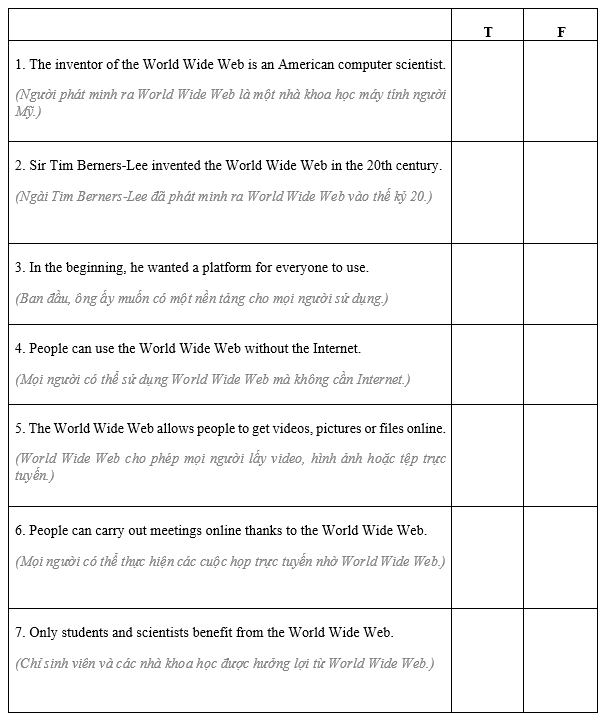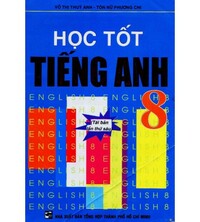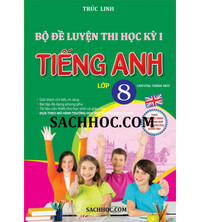Reading - Unit 11. Science and technology - SBT Tiếng Anh 8 Global Success
1. Read the passage and fill in each blank with ONE word. 2. Read the passage and tick (V) T (True) or F (False).3. Read the passages and circle the correct answer A, B, C, or D.
Bài 1
1. Read the passage and fill in each blank with ONE word.
(Đọc đoạn văn và điền vào mỗi chỗ trống với MỘT từ.)
The Importance of Science Education in Schools
Why should we teach science to children in schools? Why do many schools teach STEM subjects (science, technology, engineering, and maths)? One reason is every day children can see the benefits of (1) _______ around them, so they can be aware of the (2) _________ and technology in their everyday life. Secondly, when (3) _______ that science plays in learning science, they will learn to think in a scientific way, learn to search for the answers and to (4) ______ reasons. In other words, students can gain both knowledge of science as well as critical thinking and problem-solving (5) _______ in their (6) ______. These will be important work and studies. Moreover, if children learn science at an early age, they will be more ready to get involved (7) ________ science-related fields when they grow up.
Lời giải chi tiết:

The Importance of Science Education in Schools
Why should we teach science to children in schools? Why do many schools teach STEM subjects (science, technology, engineering, and maths)? One reason is that every day children can see the benefits of (1) science around them, so they can be aware of the (2) role and technology in their everyday life. Secondly, when (3) children / they that science plays in learn science, they will learn to think in a scientific way, learn to search for the answers and to (4) give reasons. In other words, students can gain both knowledge of science as well as critical thinking and problem-solving (5) skills in their (6) future. These will be important work and studies. Moreover, if children learn science at an early age, they will be more ready to get involved (7) in science-related fields when they grow up.
Tạm dịch:
Tầm quan trọng của giáo dục khoa học trong trường học
Tại sao chúng ta nên dạy khoa học cho trẻ em trong trường học? Tại sao nhiều trường dạy các môn học STEM (khoa học, công nghệ, kỹ thuật và toán học)? Một trong những lý do là hàng ngày trẻ em có thể nhìn thấy những lợi ích của khoa học xung quanh chúng, vì vậy chúng có thể nhận thức được vai trò và công nghệ trong cuộc sống hàng ngày của chúng. Thứ hai, khi trẻ em chơi khoa học trong học khoa học, chúng sẽ học cách suy nghĩ một cách khoa học, học cách tìm kiếm câu trả lời và đưa ra lý do. Nói cách khác, học sinh có thể đạt được cả kiến thức về khoa học cũng như tư duy phản biện và kỹ năng giải quyết vấn đề trong tương lai. Đây sẽ là những công việc và nghiên cứu quan trọng. Hơn nữa, nếu trẻ học khoa học từ khi còn nhỏ, trẻ sẽ sẵn sàng tham gia vào các lĩnh vực liên quan đến khoa học hơn khi lớn lên.
Bài 2
2. Read the passage and tick (V) T (True) or F (False).
(Đọc đoạn văn và đánh dấu (V) T (Đúng) hoặc F (Sai).)
The Invention of the World Wide Web
Sir Tim Berners-Lee, an English computer scientist, invented the World Wide Web in 1989. At first, he wanted to develop a web for scientists around the world to share information and the results of their experiments. At that time the Internet already existed. But he created a way to use the Internet to link documents to each other. Soon, he turned it into a free space for people to share knowledge, communicate, and cooperate.
The World Wide Web allows people to get all kinds of information online. The information can be images, videos, or files. It has become a significant tool for everyone, from scientists, researchers to young students as well. Scientists and researchers can share their study results, students can use it for learning or doing research online. Businesses even use it to advertise their products and to do business. Everybody can use the World Wide Web to watch videos, communicate, and attend meetings.
Tạm dịch:
Sự ra đời của World Wide Web
Ngài Tim Berners-Lee, một nhà khoa học máy tính người Anh, đã phát minh ra World Wide Web vào năm 1989. Lúc đầu, ông ấy muốn phát triển một trang web để các nhà khoa học trên khắp thế giới chia sẻ thông tin và kết quả thí nghiệm của họ. Vào thời điểm đó Internet đã tồn tại. Nhưng ông đã sáng tạo ra cách sử dụng Internet để liên kết các tài liệu với nhau. Chẳng mấy chốc, ông ấy đã biến nó thành một không gian miễn phí để mọi người chia sẻ kiến thức, giao tiếp và hợp tác.
World Wide Web cho phép mọi người có được tất cả các loại thông tin trực tuyến. Thông tin có thể là hình ảnh, video hoặc tệp. Nó đã trở thành một công cụ quan trọng cho tất cả mọi người, từ các nhà khoa học, nhà nghiên cứu cho đến các bạn sinh viên trẻ tuổi. Các nhà khoa học, nhà nghiên cứu có thể chia sẻ kết quả nghiên cứu của mình, sinh viên có thể sử dụng để học tập, nghiên cứu trực tuyến. Các doanh nghiệp thậm chí sử dụng nó để quảng cáo sản phẩm của họ và kinh doanh. Mọi người đều có thể sử dụng World Wide Web để xem video, giao tiếp và tham dự các cuộc họp.

Lời giải chi tiết:

1. F
Thông tin: Sir Tim Berners-Lee, an English computer scientist, invented the World Wide Web in 1989.
(Ngài Tim Berners-Lee, một nhà khoa học máy tính người Anh, đã phát minh ra World Wide Web vào năm 1989.)
2. T
Thông tin: Sir Tim Berners-Lee, an English computer scientist, invented the World Wide Web in 1989.
(Ngài Tim Berners-Lee, một nhà khoa học máy tính người Anh, đã phát minh ra World Wide Web vào năm 1989.)
3. F
Thông tin: At first, he wanted to develop a web for scientists around the world to share information and the results of their experiments.
(Lúc đầu, anh ấy muốn phát triển một trang web để các nhà khoa học trên khắp thế giới chia sẻ thông tin và kết quả thí nghiệm của họ.)
4. F
Thông tin: At that time the Internet already existed. But he created a way to use the Internet to link documents to each other.
(Vào thời điểm đó Internet đã tồn tại. Nhưng ông đã sáng tạo ra cách sử dụng Internet để liên kết các tài liệu với nhau.)
5. T
Thông tin: The World Wide Web allows people to get all kinds of information online. The information can be images, videos, or files.
(World Wide Web cho phép mọi người có được tất cả các loại thông tin trực tuyến. Thông tin có thể là hình ảnh, video hoặc tệp.)
6. T
Thông tin: Everybody can use the World Wide Web to watch videos, communicate, and attend meetings.
(Mọi người đều có thể sử dụng World Wide Web để xem video, giao tiếp và tham dự các cuộc họp.)
7. F
Thông tin: It has become a significant tool for everyone, from scientists, researchers to young students as well.
(Nó đã trở thành một công cụ quan trọng cho tất cả mọi người, từ các nhà khoa học, nhà nghiên cứu cho đến các bạn sinh viên trẻ tuổi.)
Bài 3
3. Read the passages and circle the correct answer A, B, C, or D.
(Đọc các đoạn văn và khoanh tròn câu trả lời đúng A, B, C hoặc D.)
No More Worries about Acne
Worried about ache? Are you worried about the side effects of using drugs to cure acne? You should be. They are toxic and have side effects. They may cause burns or red skin. Soon we may have a new drug to treat it safely.
A medical student at the University of California San Diego invented a new way to cure acne. It treats acne effectively and keeps your skin clean. The new technique uses nano-bomb technology and natural ingredients. These ingredients are from coconut oil, palm oil, human milk, cow's milk, and goat's milk. These nano-bombs find the bacteria causing acne then they attack and kill the bacteria.
Robots with the Sense of Touch
Guess what? We will soon have robots with the sense of touch. We already have smart robots that can dance, smile, and teach different subjects. But now scientists are developing robots with skin that can sense. These new robots will have skin on their fingers made from thin pieces of rubber. The skin will help robots sense because it will be very much like human skin. Scientists said that these robots would be able to sense pressure and temperature.
Tạm dịch:
Không Còn Nỗi Lo Về Mụn
Lo lắng về đau? Bạn lo lắng về tác dụng phụ khi sử dụng thuốc để trị mụn? Bạn nên. Chúng độc hại và có tác dụng phụ. Chúng có thể gây bỏng hoặc đỏ da. Chúng ta có thể sớm có một loại thuốc mới để điều trị bệnh này một cách an toàn.
Một sinh viên y khoa tại Đại học California San Diego đã phát minh ra một phương pháp mới để trị mụn trứng cá. Nó điều trị mụn trứng cá hiệu quả và giữ cho làn da của bạn sạch sẽ. Kỹ thuật mới sử dụng công nghệ bom nano và các thành phần tự nhiên. Những thành phần này là từ dầu dừa, dầu cọ, sữa người, sữa bò và sữa dê. Những quả bom nano này tìm ra vi khuẩn gây mụn sau đó chúng tấn công và tiêu diệt vi khuẩn.
Robot có xúc giác
Đoán xem? Chúng ta sẽ sớm có robot có xúc giác. Chúng ta đã có những người máy thông minh có thể nhảy múa, mỉm cười và dạy các môn học khác nhau. Nhưng giờ đây các nhà khoa học đang phát triển những con robot có làn da có thể cảm nhận được. Những robot mới này sẽ có da trên ngón tay làm từ những miếng cao su mỏng. Da sẽ giúp robot có cảm giác vì nó sẽ rất giống da người. Các nhà khoa học cho biết, những robot này sẽ có thể cảm nhận được áp suất và nhiệt độ.
1. Acne medications are ______.
A. worried B. worrying
C. ineffective D. safe
2. Current drugs are ______.
A. safe B. red
C. toxic D. effective
3. Which is NOT true of the nano-bomb?
A. It has natural ingredients.
B. It seeks out bacteria.
C. It attacks bacteria.
D. It kills bacteria.
4. Which sense will new robots have?
A. Hearing. B. Sight.
C. Touch. D. Humour.
5. The robots can sense by using their ______.
A. hands B. arms
C. rubber D. fingers
6. They have skin made from ______.
A. rubber B. human skin
C. plastic D. nylon
7. The passages are from ______.
A. scientific books
B. announcements
C. non-fiction stories
D. guidebooks
Lời giải chi tiết:

1. B
Acne medications are worrying.
(Thuốc trị mụn đáng lo ngại.)
Giải thích:
A. worried (adj): lo lắng
B. worrying (adj): lo lắng
C. ineffective (adj): không hiệu quả
D. safe (adj): an toàn
Thông tin: Worried about ache? Are you worried about the side effects of using drugs to cure acne? You should be.
(Lo lắng về đau? Bạn lo lắng về tác dụng phụ khi sử dụng thuốc để trị mụn? Bạn nên.)
2. C
Current drugs are toxic.
(Thuốc hiện nay độc hại.)
Giải thích:
A. safe (adj): an toàn
B. red (adj): đỏ
C. toxic (adj): độc hại
D. effective (adj): hiệu quả
Thông tin: They are toxic and have side effects.
(Chúng độc hại và có tác dụng phụ.)
3. A
Giải thích:
Which is NOT true of the nano-bomb?
(Điều nào KHÔNG đúng với bom nano?)
A. It has natural ingredients. (Nó có thành phần tự nhiên.)
B. It seeks out bacteria. (Nó tìm kiếm vi khuẩn.)
C. It attacks bacteria. (Nó tấn công vi khuẩn.)
D. It kills bacteria. (Nó giết chết vi khuẩn.)
Thông tin: These ingredients are from coconut oil, palm oil, human milk, cow's milk, and goat's milk.
(Những thành phần này là từ dầu dừa, dầu cọ, sữa người, sữa bò và sữa dê.)
4. C
Giải thích:
Which sense will new robots have?
(Robot mới sẽ có ý nghĩa gì?)
A. Hearing (n): thính giác
B. Sight (n): thị giác
C. Touch (v): chạm vào
D. Humour (n): hài hước
Thông tin: We will soon have robots with the sense of touch.
(Chúng ta sẽ sớm có robot có xúc giác.)
5. D
The robots can sense by using their fingers.
(Các robot có thể cảm nhận được bằng cách sử dụng ngón tay của chúng.)
Giải thích:
A. hands (n): tay
B. arms (n): cánh tay
C. rubber (n): cao su
D. fingers (n): ngón tay
Thông tin: These new robots will have skin on their fingers made from thin pieces of rubber.
(Những robot mới này sẽ có da trên ngón tay làm từ những miếng cao su mỏng.)
6. A
They have skin made from rubber.
Giải thích:
A. rubber (n): cao su
B. human skin (n): da người
C. plastic (n): nhựa
D. nylon (n): nylon
Thông tin: These new robots will have skin on their fingers made from thin pieces of rubber.
(Những robot mới này sẽ có da trên ngón tay làm từ những miếng cao su mỏng.)
7. B
The passages are from announcements.
(Các đoạn văn là từ các thông báo.)
Giải thích:
A. scientific books: sách khoa học
B. announcements: thông báo
C. non-fiction stories: truyện phi hư cấu
D. guidebooks (n): sách hướng dẫn
Thông tin: Các đoạn văn là từ các thông báo.
Search google: "từ khóa + timdapan.com" Ví dụ: "Reading - Unit 11. Science and technology - SBT Tiếng Anh 8 Global Success timdapan.com"







